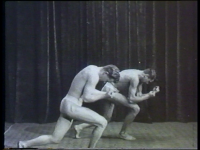
The expressive dance developed in Germany from the decade of the 20th century by Rudolf von Laban and later Mary Wigman is also known abroad as German Dance or German Expressionist Dance. Originating in German Expressionism in painting and poetry, A. turned against the dance definition of classical ballet, which was perceived as too narrow. “Every human being is a dancer”, Laban proclaimed, and every movement could be a dance movement. Dance should be an expression of inner movement.
With his new concept of freedom, the A. created a hitherto unknown mass movement and tried to improve the social situation for dance at the German Dancers’ Congresses.
In addition to Laban and Wigman, the protagonists of the A. included Gret Palucca, Yvonne Georgi and Harald Kreutzberg. Dore Hoyer helped the A. to a late choreographic flowering. The work of Laban’s student Kurt Jooss at the Folkwangschule in Essen, from which some of the most important protagonists of the Dance Theatre![]() emerged.
emerged.
(Norbert Servos)
